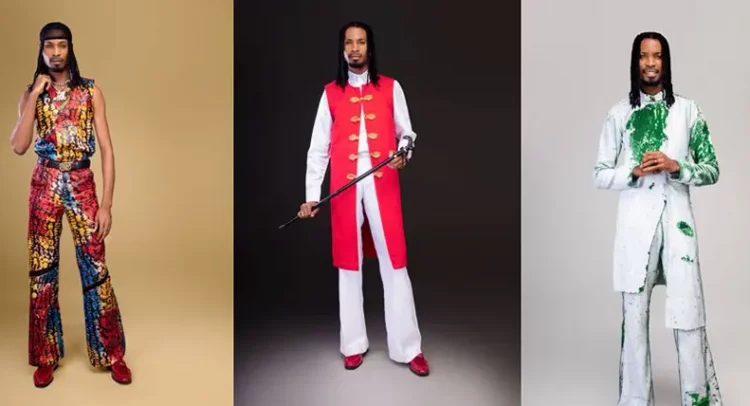If we consider clothing as an autobiography, then these three looks from the “Afro Mix” by Ranto Clothings under the creative direction of Bright Urhobo, would read like chapters of a book told in different tempos, a dance track, a procession, a hymn. What binds them isn’t just the clamour for menswear’s recent theatricality. It is rather a studied insistence that style can be a language of belonging, elastic, joyous, and disobedient all at once.
The Dance Track, Dye and Fire – The first look advances in rhythm of a highlife star; a sleeveless top and flared trousers cut in resist-dyed fabric, indigo shocked into red and yellow, night nudged into sunrise. The print doesn’t want to be polite, it is a conversation in the open street. A black belt with a lion buckle interrupts the chroma like a punctuation reminding us that pageantry requires grammar. Red platform shoes complete the sentence, without whispering.
There’s a genealogy here, talk Afrobeat-era Lagos tailoring, 1970s Ibadan campus swagger, the nightclub photographs of Okhai Ojeikere’s era, 1970s musicians album covers. But this particular look is not nostalgia, it is the alternative. The durag, the stacked chains, the “KING” pendant operates as an annotation in contemporary slang, if it was voiced would sound like “I know the archive, but I choose my present.”
There is no pulling this without extreme attention to the cut, the flares begin low enough to lengthen the shin, the sleeveless armhole is high enough to read sculptural, not gym-bro. The set is edited, so the print carries meaning without weight. You can almost hear fabric on fabric, that small rustle of wax-dyed cotton speaking like percussion. This is what joy looks like when it understands discipline.
The Procession, A New Uniform of Ceremony, the second chapter steps into light like a guard changing at the palace. A long, red waistcoat with gold frog fastenings is set over a razor white shirt and flared trousers. It is a uniform but not of any known army, a kind of secular regalia. The stick helps, not as a prop but as a metronome. Every gesture appears measured from the coat’s verticality to the devotional calm.
In a culture where tailoring often negotiates between the suit and the agbada, this look proposes a third way, the slim column of a European guard’s coat, emptied of militarism and filled with pageantry. The gold closures are leaflike, almost Benin-bronze in their suggestion, while the shirt collar is monastic. The white trousers widen just enough to give the silhouette swing, and red shoes glossed, almost ecclesiastical, repeating the coat’s chroma, anchoring the look like a refrain.
There’s a softer politics here. The coat is an emblem of authority that refuses aggression. It says: a man can be ceremonial without being domineering, can lead a procession without shouting. That is not small in any fashion sense.
The Hymn, a Cartography of Light, the final look is the quietest and the most declarative, a long sequinned tunic and flared trousers in white, mottled with green that surfaces like a shoreline. The pattern reads as a cartography, accidental or intended, evoking the silhouette of Nigeria without rendering it into graphic cliché. It’s national color as an abstraction, a rare sophistication in patriotic dress.
Under studio lights the sequins behave like a tide, green pooling and receding at the same time, allowing the garment a life of its own. The tunic’s placket is clean, a side slits allowing movement and the trousers maintain the collection’s throughline of seventies width. He stands, hands clasped, and the clothes speak of an intimacy that sparkles rarely allows. To use brightness as an instrument of modesty is a feat.
This look understands the theology of white, renewal and borderless possibility. It suggests that citizenship, too, can be worn lightly, no flags, no slogans, just a shimmer of belonging.
This collection says across the three looks, that with volume comes memory. Flares and long coats aren’t retro quotations; they are capacities for movement. The legs swing like pendulums and the coat traces the air. The red isn’t simply hot; it’s a ritual. Green is not only verdure; it’s a map. The multicolor dye prints are not noise; they’re polyphony, each hue a voice that refuses to be alone. The chains, buckles, frogs and sequins are not afterthoughts but verbs. They add action to a look, turning clothing into a verb, “to dress as to declare.”
There is also a conversation with masculinity. Sleeveless ease beside formal regalia, sparkle beside strict tailoring, it’s a presentation of manhood with range. The bodies here do not perform hardness. They perform with intention. Even the stick, historically a symbol of authority, becomes an instrument of choreography.
On a closer inspection, the tailoring lands. Armholes are cut high; shoulder seams sit square; the red coat falls perpendicular to the floor; the sequin tunic hides its closures with monkish restraint. If a refinement is to be made, it is in hemming the white trousers to float a centimeter higher above the shoe, allowing the flare to maintain its bell without break. But the overall finish respects the silhouettes it quotes.
Textile choice is a case study in character, wax-dyed cotton for the extrovert, dense suiting for the statesman, sequinned knit for the mystic. If the collection is a chorus, the designer has tuned the voices to different keys and let them harmonize around a single lyric presence.
Fashion is a wager that what we wear can move a story forward. This collection places its bet on daring that is tender, on grandeur that leaves room for a smile and it wins.
By Daniel Usidamen


